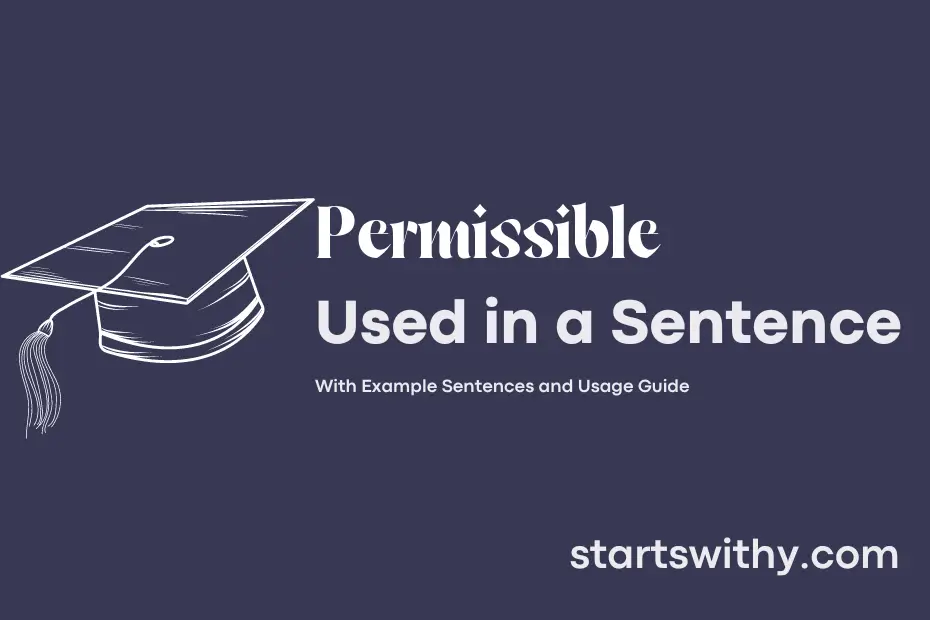Do you ever wonder if it’s okay to do something within the bounds of the rules or law? That’s where the concept of “permissible” comes into play. “Permissible” simply means that something is allowed or acceptable according to a set of rules, guidelines, or standards.
In various situations, knowing what is permissible can help you make informed decisions and navigate boundaries effectively. Understanding what is permissible ensures that you stay within the limits of what is considered acceptable or appropriate.
7 Examples Of Permissible Used In a Sentence For Kids
- Eating fruits and vegetables is permissible during snack time.
- Sharing toys with friends is permissible in our classroom.
- Asking questions when you don’t understand is permissible.
- Being kind to everyone is always permissible.
- Raising your hand to speak is permissible in class.
- Running and playing outside is permissible during recess.
- Using kind words with each other is always permissible.
14 Sentences with Permissible Examples
- Eating in the library is permissible as long as you clean up after yourself.
- It is permissible to reschedule a midterm exam for a valid reason with prior approval from your professor.
- Sharing study material with classmates is permissible as long as it is not plagiarized.
- Using online resources to supplement your research is permissible but make sure to properly cite your sources.
- Taking a break from studying is permissible to prevent burnout and maintain mental health.
- Asking for an extension on a project deadline is permissible in certain situations, such as illness or personal emergencies.
- Forming study groups with classmates is permissible to collaborate and learn from each other.
- Using technology in the classroom is permissible as long as it enhances the learning experience.
- Attending a career fair during class hours is permissible if it aligns with your career goals and aspirations.
- Discussing different viewpoints in a respectful manner is permissible in academic settings to promote critical thinking.
- Using calculators during exams is permissible if specified by the professor and is relevant to the course material.
- Forming extracurricular clubs on campus is permissible to pursue interests outside of academics.
- Taking electives outside of your major is permissible to explore diverse subjects and broaden your knowledge base.
- Utilizing academic support services, such as tutoring or counseling, is permissible to enhance your overall college experience.
How To Use Permissible in Sentences?
Permissible is a word used to describe something that is allowed or acceptable within the boundaries of the law, rules, or social norms. Here’s a guide on how to use it in a sentence:
-
Identify the context: Before using Permissible in a sentence, make sure you understand the rules or norms that apply to the situation. Consider whether an action is permitted or if there are any restrictions in place.
-
Place the word appropriately: Permissible is typically used before a noun to describe whether something is allowed or not. For example, “Smoking is not permissible in this area.”
-
Use it in a sentence: When constructing a sentence with the word Permissible, ensure that the context of permission or acceptability is clear. For example, “It is not permissible to park in this area overnight.”
-
Check for accuracy: Double-check that the usage of Permissible aligns with the intended meaning of conveying what is allowed or acceptable. This will help avoid confusion.
-
Practice makes perfect: To become more comfortable using Permissible in sentences, practice by incorporating it into your daily conversations or writing exercises. This will help you become more familiar with its usage and nuances.
By following these steps, you can effectively use Permissible in a sentence to communicate whether something is permitted or acceptable. With practice, you will gain confidence in utilizing this word correctly in various contexts.
Conclusion
In conclusion, sentences that are permissible are those that conform to rules, standards, or laws and are considered acceptable or allowed. These sentences are appropriate within a given context and adhere to guidelines or boundaries set by a particular authority or system. For example, permissible sentences in a legal context are those that comply with existing laws and regulations, while permissible sentences in a classroom setting are those that follow academic standards and guidelines.
Understanding what makes a sentence permissible is essential for effective communication and for ensuring that messages are conveyed appropriately and in accordance with established norms. By adhering to permissible sentences, individuals can avoid ambiguity, misunderstanding, or potential repercussions that may arise from using language that is not considered acceptable or appropriate within a specific context.



